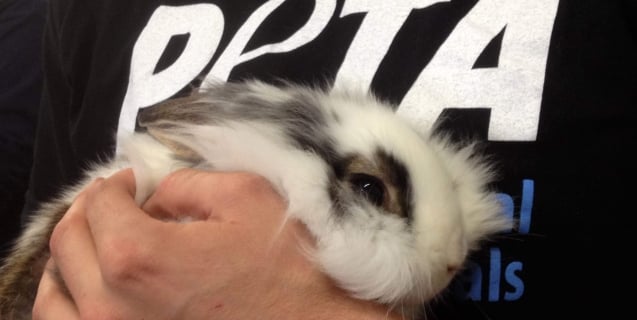The cartoon rabbits pictured on Easter cards may look cute and cuddly, but real rabbits have no place in the “pet” industry. These complex animals are often purchased on a whim, especially in the spring, and potential caretakers rarely understand the specific needs of their new companion. Once the novelty has worn off, many bunnies are neglected, relegated to outdoor cages, dumped at shelters, or simply turned loose in the wild, where they have little chance of surviving. Hundreds of organizations and shelters are trying to deal with this growing problem.

Dealers and “pet” stores usually request 4-week-old bunnies because they require less space and are “cuter,” but bunnies of this age are ill-prepared to be weaned from their parents. Many people who purchase these young, small bunnies do not realize that depending on breed, the average weight for an adult rabbit is anywhere from 2 to 20 pounds.
Rabbits are social creatures with gentle natures and individual personalities, and they need just as much attention as a dog or cat. They are not suitable companions for young children. Rabbits require specific foods, stimulating environments, and veterinarians who have specialized knowledge of their species.
How to Spot Neglect
Federal regulations apply only to those breeders or “bunny mills” that do at least $500 of business with a particular pet store, and enforcement is lax, so the rabbits that you see in the store may not have been properly transported or cared for.
A runny nose, sneezing, head-tilt, listlessness, and diarrhea are all signs of a sick bunny. Rabbits have extremely delicate respiratory and digestive systems, and any change in the balance of these systems can result in death if they are not treated properly and quickly. Bare spots or scabs anywhere on the body suggest that the rabbit has parasites or has been fighting with other rabbits.
Adoption
If—after careful consideration—you have decided to welcome a rabbit into your home, please adopt from your local humane society or rabbit rescue group. Rabbits can live up to 10 years and require annual checkups by a veterinarian who is familiar with rabbits. Bunnies need lots of company and can become withdrawn and depressed if not provided with plenty of love and companionship. Rabbits do get along with dogs and cats if they are all safely socialized.
If you plan to adopt two rabbits, consider a neutered male and a spayed female, as they are usually more compatible than two fixed same-sex bunnies. It is crucial to have your new companion spayed or neutered immediately. Otherwise, males mark their territory, females run a high risk of uterine cancer, and the already serious overpopulation crisis becomes worse.
Rabbit-Proofing
Rabbits cannot tolerate extreme heat and must be provided with shelter from the cold. They prefer to live indoors, where they can participate in their caretaker’s everyday life, but before you let your new friend into your home, there are a few things you need to do to ensure his or her safety and happiness. Bunnies are natural chewers and they love to play, so be sure to provide plenty of toys. Untreated wood; straw; wire cat-balls; keys; paper towel rolls; and hard, plastic baby toys work well, but even with all these fun toys to play with, bunnies are drawn to electrical and phone wires, books, baseboard molding, door jams, and plants.
You’ll need to cover or redirect wires and move the rest of these items up and out of the way before bringing your bunny home. You’ll also want to set up a large box or basket filled with shredded paper for your new companion to dig in. Not all rabbits are chronic diggers, but those who are will take their natural digging instincts out on your rugs and other furnishings unless you’ve supplied an alternate digging spot. And while you’re setting up, don’t forget that rabbits also need a safe, quiet haven such as a cardboard box or plastic carrier with a towel inside. Wire cages are not suitable for bunnies.
Litter Training
Litter training is possible at any age—since rabbits like to relieve themselves in one place—and older rabbits tend to be quicker students than youngsters. Even if you plan on giving the bunny the run of the house, you’ll need to conduct litter training in a relatively confined space. Fill a litterbox with paper pulp litter. Do not use clay, as it is deadly for rabbits’ delicate digestive systems! Place the litter box in the corner of the cage or room. Try encouraging your rabbit by putting some of his or her droppings into the box or try using timothy hay or treats. Rabbits learn easily, and before long, you will be able to leave litterboxes in different locations around the house.
“We’re Vegetarians, Thank You!”
The bulk of a rabbit’s diet should be grass, timothy or oat hay, and fresh vegetables. You may also try giving a limited amount of pellets and a small amount of fruit to him or her. Dark leafy greens, broccoli, carrots, parsley, watercress, bananas, apples, pears, and pineapples are all good choices. Stay away from iceberg lettuce (too much water) or large amounts of cabbage (can give a bunny gas). Like dogs or cats, rabbits may be prone to begging at the table. As tempting as it may be to give your rabbit a taste of whatever it is that you’re eating, rabbits have digestive systems that are easily disrupted, so you should stick to his or her normal diet. Check with your vet before you add other treats.
Grooming and Handling
Although rabbits clean themselves much as cats do, rabbits do not have the ability to cough up hairballs, so it is imperative that you groom your rabbit a least once a week. Most rabbits love the attention and grooming prevents digestive problems later in life
Rabbits are instinctively nervous when lifted off the ground. Because of the delicate structure of their spines and the power of their leg muscles, struggling rabbits can actually break their own backbones. Never lift a rabbit by the ears or with just one hand under the stomach. Rabbits do not like to be carried around as cats or dogs might. It is best to get down on their level to interact with them, but if you must pick your rabbit up, make sure that you are supporting his or her hind legs and rump at all times and using your other hand to support his or her chest. Once acclimated to your home, bunnies will come to you, jump into your lap, and even sleep with you.
Resources
House Rabbit Society
Friends of Rabbits
Rabbit Roundabout
Rabbit Welfare Association
Text VEG to 73822 to get the latest vegan lifestyle tips, recipes, and urgent action alerts texted right to your phone.
Terms for automated texts/calls from PETA: https://peta.vg/txt. Text STOP to end, HELP for more info. Msg/data rates may apply. U.S. only.







